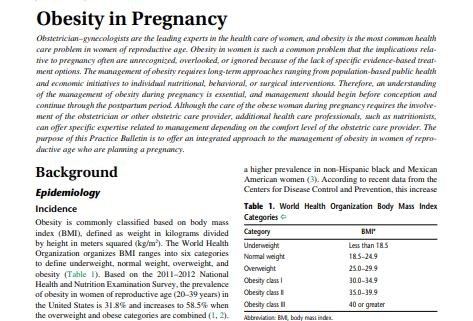OBESITY IN PREGNANCY
Obstetrician–gynecologists are the leading experts in the healthcare of women, and obesity is the most common healthcare problem in women of reproductive age. Obesity in women is such a common problem that the implications relative to pregnancy often are unrecognized, overlooked, or ignored because of the lack of specific evidence-based treatment options. The management of obesity requires long-term approaches ranging from population-based public health and economic initiatives to individual nutritional, behavioral, or surgical interventions. Therefore, an understanding of the management of obesity during pregnancy is essential, and management should begin before conception and continue through the postpartum period. Although the care of the obese woman during pregnancy requires the involvement of the obstetrician or another obstetric care provider, additional health care professionals, such as nutritionists, can offer specific expertise related to management depending on the comfort level of the obstetric care provider. The purpose of this Practice Bulletin is to offer an integrated approach to the management of obesity in women of reproductive age who are planning a pregnancy.
Background
Epidemiology Incidence Obesity is commonly classified based on body mass index (BMI), defined as weight in kilograms divided by height in meters squared (kg/m2). The World Health Organization organizes BMI ranges into six categories to define underweight, normal weight, overweight, and obesity (Table 1). Based on the 2011–2012 National Health and Nutrition Examination Survey, the prevalence of obesity in women of reproductive age (20–39 years) in the United States is 31.8% and increases to 58.5% when the overweight and obese categories are combined (1, 2).



